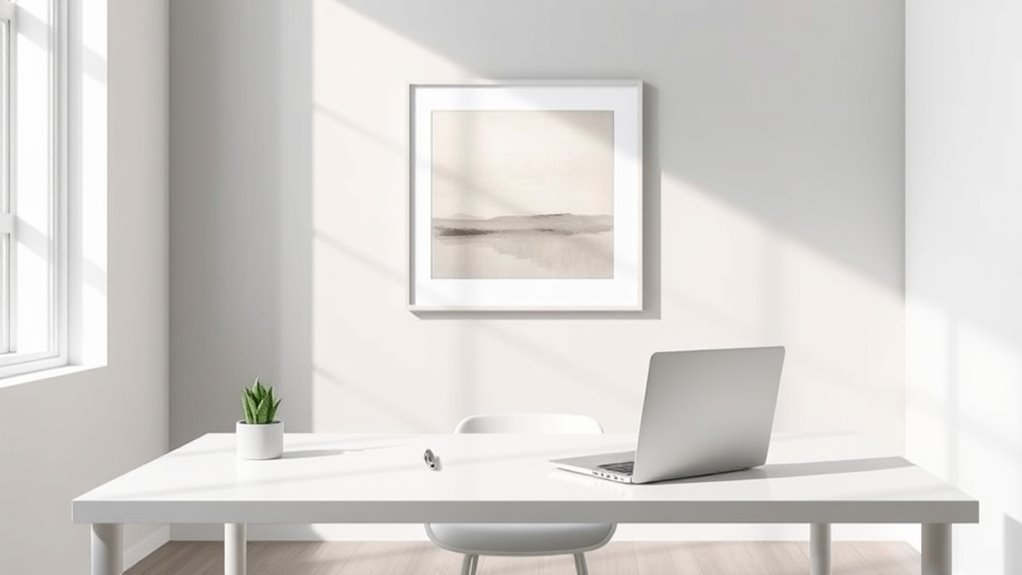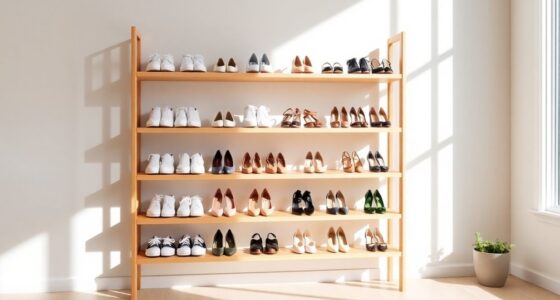Corporate adoption of minimalism focuses on creating simplified, clutter-free workspaces that boost productivity and well-being. By reducing distractions, choosing functional furniture, and maintaining consistent branding, businesses promote focus and clarity. These environments reduce employee stress and support mental health. Implementation involves decluttering, ergonomic choices, and digital detox strategies. Embracing these principles can transform your work environment—so, explore how future trends will shape minimalist workplace design and enhance your space.
Key Takeaways
- Corporations adopt minimalism to streamline workspaces, enhance focus, and promote efficiency through decluttering and simplified design.
- Many companies implement digital detoxes and remote work policies to reduce digital clutter and improve employee well-being.
- Minimalist office environments often incorporate neutral tones, ergonomic furniture, and natural elements to boost productivity and reduce stress.
- Challenges include overcoming cultural resistance, traditional corporate norms, and costs associated with redesigning spaces.
- Future trends involve integrating smart technology, hidden storage, and biophilic design to support sustainable and adaptable workplaces.
The Origins of Minimalism in Business Environments
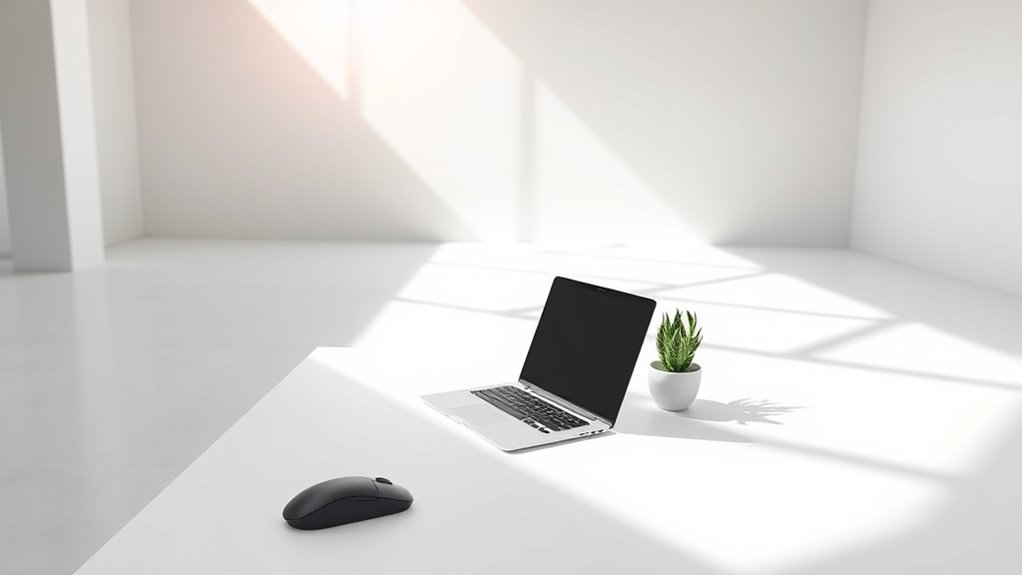
The origins of minimalism in business environments can be traced back to the broader minimalist movement that emerged in art and design during the mid-20th century. This movement’s historical evolution emphasized simplicity, functionality, and clean lines, rejecting ornate details. A key influence was the focus on reducing clutter, which aimed to create environments that foster clarity and efficiency. Aesthetic influences from artists like Donald Judd and Agnes Martin inspired designers to prioritize clarity and purpose. As these ideas spread, companies began adopting minimalist principles to streamline workspaces and improve productivity. Over time, minimalism’s focus on reducing clutter and emphasizing essential elements transformed into a corporate philosophy. This shift reflected a desire for efficiency, clarity, and professionalism. Additionally, the minimalist movement’s emphasis on simplicity in design influenced modern office layouts to promote focus and reduce distractions. Recognizing the importance of financial management in maintaining streamlined operations, many organizations also adopted minimalist strategies to control costs and optimize resources. Implementing cost-effective production methods further supported the goal of reducing expenses and waste in creating office environments. Incorporating standardized procedures further supported consistent and efficient workflows within minimalist environments. Today, the aesthetic influences of the minimalist movement continue to shape modern office design, fostering environments that promote focus and purpose.
Key Principles Driving Corporate Minimalism
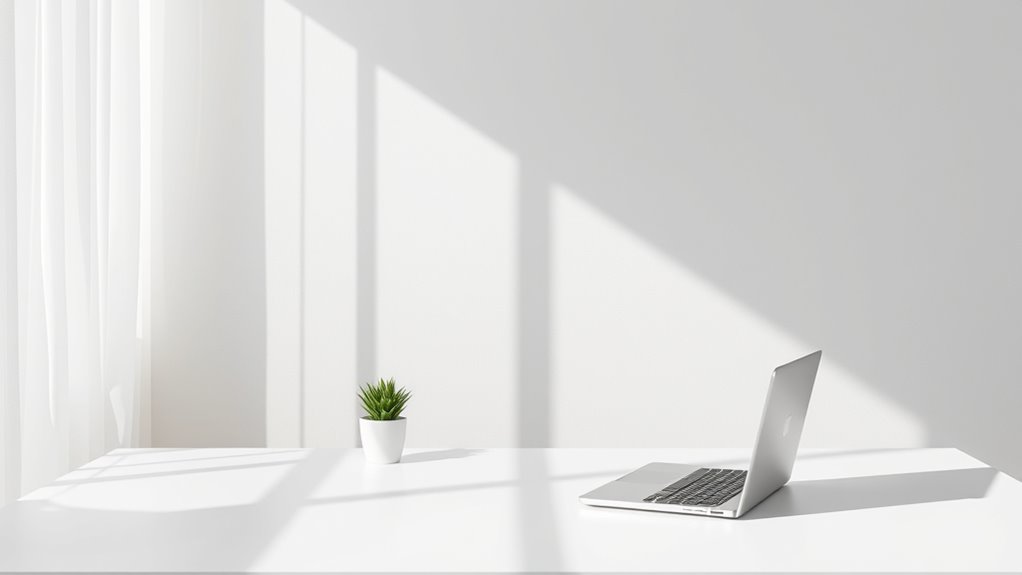
At the core of corporate minimalism are principles that prioritize simplicity, functionality, and intentionality. You focus on clean design aesthetics that eliminate clutter, making spaces more efficient and visually appealing. Synthetic wigs require careful styling to maintain their appearance, highlighting the importance of selecting the right products and techniques. Branding consistency ensures all elements—from logos to marketing materials—align seamlessly, reinforcing your company’s identity. You emphasize quality over quantity, selecting essential items that serve a purpose. This approach streamlines workflows and reduces distractions, fostering clarity. Additionally, adopting minimalist workflows can enhance productivity by reducing unnecessary steps and focusing on core objectives. Applying regional legal resources effectively can also help organizations navigate compliance and legal considerations in different locations. Implementing innovative design elements can further elevate the minimalist workspace and support organizational goals. To visualize, consider this table:
| Principle | Focus | Outcome |
|---|---|---|
| Simplicity | Minimalist design | Clear, cohesive environments |
| Functionality | Practical, user-centered | Efficient, user-friendly spaces |
| Intentionality | Purpose-driven choices | Reduced clutter, focused goals |
| Branding Consistency | Uniform visuals and messaging | Strong, recognizable identity |
Benefits for Employee Well-Being and Productivity

When your workspace is simplified, you’ll notice less stress and a clearer mind. Incorporating privacy policies ensures that your personal data remains protected even in a minimalistic environment. Additionally, establishing clear data security protocols helps safeguard sensitive information in streamlined workspaces. Implementing these protocols is especially important given the cybersecurity threats that can affect even small-scale businesses. Regularly updating your security measures can further enhance protection against emerging risks. Staying informed about best practices in cybersecurity can help you adapt to evolving digital threats. This focus helps you stay productive and feel more balanced between work and personal life. Embracing minimalism can truly boost both your well-being and efficiency.
Reduced Stress Levels
Because cluttered and chaotic workspaces can increase feelings of overwhelm, adopting minimalism helps reduce stress by creating a calm and organized environment. When your workspace is streamlined, you experience less mental clutter, making it easier to focus and feel at ease. Incorporating regular digital detoxes further enhances stress reduction, as it minimizes constant notifications and digital distractions that can heighten anxiety. Simplifying your surroundings and limiting digital interruptions promote a sense of control and tranquility. This environment encourages relaxation, allowing you to concentrate on tasks without feeling overwhelmed. Additionally, maintaining an organized workspace aligns with the principles of home organization, fostering long-term mental clarity and well-being. Moreover, understanding Louisiana alimony laws can help professionals feel more secure about financial planning, reducing stress related to potential legal disputes.
Enhanced Focus and Clarity
A clutter-free workspace not only reduces stress but also sharpens your focus and clarity. When your environment is organized, digital decluttering becomes easier, eliminating distracting notifications and unnecessary files that can disrupt your concentration. Developing attention skills through minimalism ensures sustained focus over longer periods. This streamlined setup allows you to prioritize tasks efficiently, leading to focus enhancement. With fewer visual and digital distractions, you can maintain better attention on your work, making decisions faster and improving overall productivity. Minimalism encourages you to concentrate on what truly matters, helping you avoid overwhelm and mental fatigue. As your workspace clears, your mind follows suit, enabling clearer thinking and better problem-solving. Implementing effective strategies for decluttering can further support these benefits by creating lasting habits that promote organization. Cultivating mental clarity through minimalism not only benefits your work but also enhances your overall well-being. Embracing a minimalist approach creates an environment where focus and clarity naturally flourish, supporting your well-being and work performance.
Improved Work-Life Balance
Have you ever noticed how a cluttered workspace can spill over into your personal life, making it harder to disconnect after work hours? Minimalist office designs, from simple break room decor to streamlined dress code policies, help create clear boundaries between work and personal time.
When your environment is uncluttered, you feel less overwhelmed and more in control. This clarity reduces stress and fosters better work-life balance, allowing you to focus on what matters outside of office hours.
Strategies for Implementing Minimalist Office Designs
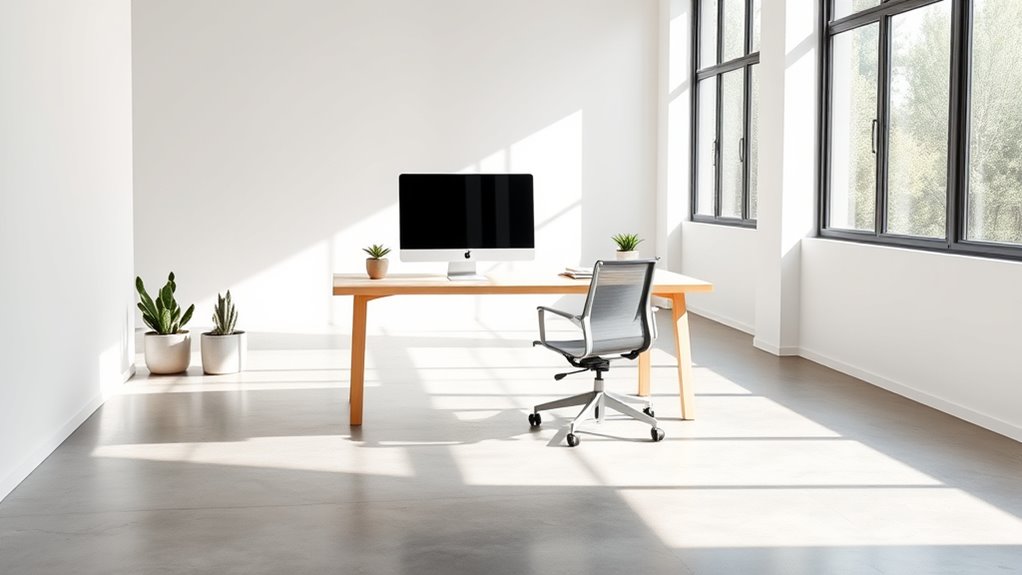
To effectively implement minimalist office designs, start by evaluating your current workspace and identifying areas cluttered with unnecessary items. Focus on decluttering surfaces and storage spaces, making room for essential items only. Choose ergonomic furniture to promote comfort and productivity without excess. Use color psychology to create a calming atmosphere—soft neutrals or muted tones can reduce stress. Consider these key strategies:
| Step | Action | Purpose |
|---|---|---|
| Declutter | Remove unnecessary items | Clear mental and physical space |
| Select ergonomic furniture | Prioritize comfort and function | Improve well-being |
| Use calming colors | Incorporate neutral or muted tones | Enhance focus and reduce stress |
Case Studies of Companies Embracing Minimalism

Many companies are transforming their workspaces by adopting minimalist principles, recognizing the benefits of streamlined environments for productivity and well-being. For example, a tech startup reduced clutter and embraced remote work, allowing employees to focus better and cut distractions.
Adopting minimalist workspaces enhances focus, well-being, and overall productivity.
Another company prioritized digital detox by limiting unnecessary emails and notifications, fostering calmer work habits. Meanwhile, a financial firm simplified its office layout, encouraging employees to work in quiet, open spaces that enhance concentration.
These companies show that minimalism boosts efficiency and mental clarity.
- Emphasizing remote work to reduce physical clutter
- Encouraging digital detox for better focus
- Creating open, clean workspaces for enhanced concentration
Challenges and Considerations in Adopting Minimalism

Adopting minimalism in your workplace can face resistance rooted in company culture or employee habits.
You’ll also need to take into account the costs involved in redesigning spaces and updating supplies.
Ensuring consistency over time becomes a challenge as priorities and perceptions evolve.
Cultural Resistance Challenges
Even though minimalism promises increased efficiency and clarity, cultural resistance often hampers its adoption in the workplace. Many organizations cling to corporate traditions that emphasize excess, clutter, and visual complexity, making change difficult.
Employee resistance also plays a significant role, as staff may fear losing status or familiarity with their environment.
To overcome these challenges, consider these factors:
- Deep-rooted corporate traditions that associate productivity with abundance can hinder minimalist shifts.
- Fear of change prompts employees to resist reducing personal or shared workspaces.
- Perceived value of clutter as a sign of busyness or success can make minimalism seem like a step backward.
Understanding these resistance points helps you navigate cultural hurdles and foster acceptance of minimalism in your organization.
Cost of Implementation
Implementing minimalism in the workplace often involves significant upfront costs and logistical challenges. You need to take into account budget constraints, which can limit your options for redesign and procurement. Selecting the right vendor becomes vital; a poor choice can inflate costs or delay progress. You might face unexpected expenses, such as specialized furniture or software. To help visualize, here’s a quick comparison:
| Consideration | Impact |
|---|---|
| Budget Constraints | Limits options, requires prioritization |
| Vendor Selection | Affects quality, cost, and implementation speed |
| Initial Costs | Furniture, decluttering, system upgrades |
| Long-term Savings | Reduced maintenance, increased productivity |
Careful planning and vendor research are essential to minimize costs and guarantee smooth execution.
Maintaining Consistency
Maintaining consistency in a minimalist workplace can be challenging because it requires ongoing discipline and commitment from everyone involved. To preserve your brand identity and aesthetic consistency, you need clear guidelines and regular reinforcement.
- Guarantee all team members understand the core principles of minimalism and how they reflect your brand.
- Regularly review your workspace and materials to eliminate clutter and uphold a uniform look.
- Communicate the importance of consistency in visual elements, messaging, and behavior to foster a cohesive environment.
Balancing flexibility with strict adherence helps prevent drift from your minimal aesthetic. If team members deviate, it can dilute your brand identity and undermine the minimalist ethos.
Staying vigilant and committed ensures your workspace remains aligned with your minimalist goals.
Future Trends in Minimalist Workplace Design
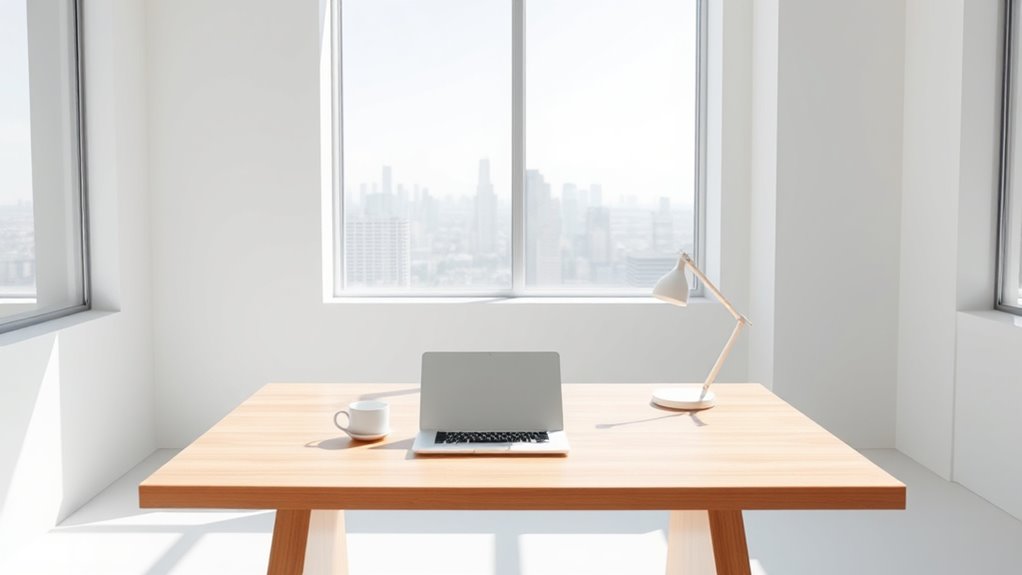
As companies continue to prioritize simplicity and efficiency, future trends in minimalist workplace design will focus on integrating technology seamlessly while enhancing employee well-being.
You’ll see more use of biophilic elements, such as natural light, plants, and organic materials, to create calming, health-promoting environments.
Smart technology will play a key role, enabling adaptive lighting, climate control, and noise reduction that respond to individual needs without cluttering the space.
Open, clutter-free layouts will incorporate hidden storage and multifunctional furniture to maintain simplicity.
Virtual collaboration tools will reduce physical clutter, making spaces more flexible.
Frequently Asked Questions
How Does Minimalism Influence Company Culture and Brand Perception?
You might notice that minimalism shapes company culture and brand perception by fostering mindful communication and promoting inclusive design.
When you adopt minimalist principles, your organization encourages clarity, reducing clutter and misunderstandings. This approach signals that you value simplicity and accessibility, making your brand more approachable.
Ultimately, minimalism helps you cultivate a positive environment where everyone feels included, and your brand is seen as modern, thoughtful, and user-centric.
What Are Common Pitfalls When Transitioning to a Minimalist Workspace?
Switching to a minimalist workspace can feel like a breath of fresh air, but beware of common pitfalls. You might end up with decorative clutter or excessive furnishings that counteract simplicity.
It’s easy to underestimate how hard it’s to maintain that clean look, leading to clutter creeping back in. Focus on intentional design, eliminate unnecessary items, and resist the urge to overdecorate, ensuring your workspace stays truly minimalist.
How Do Minimalism Strategies Vary Across Different Industries?
You’ll notice that minimalism strategies vary across industries based on their unique needs. For example, tech companies might focus on sleek office decor that promotes innovation, while finance firms may prioritize clutter-free spaces that emphasize professionalism.
Regardless, maintaining minimalist deadlines helps keep projects on track without unnecessary stress. Tailoring these strategies guarantees your workspace remains functional and inspiring, aligning with your industry’s specific demands.
What Role Does Technology Play in Supporting Minimalist Work Environments?
Imagine a workspace so clutter-free, it feels like a gust of fresh air—technology makes this possible. Digital tools and virtual collaboration platforms streamline tasks and eliminate chaos, turning your work environment into a sleek, focused space.
They support minimalism by reducing physical clutter and simplifying communication. With technology, you can work smarter, not harder, creating a minimalist environment that boosts productivity and clarity effortlessly.
How Is Employee Feedback Incorporated During Minimalist Workspace Redesigns?
During a workspace redesign, you should prioritize feedback integration by actively listening to employee suggestions and concerns. Your role is to guarantee that the redesign process remains collaborative, encouraging open communication.
Conclusion
As you embrace minimalist design, imagine a workspace where clarity flows like a gentle breeze, freeing your mind to focus and innovate. With clean lines, uncluttered surfaces, and intentional simplicity, you create an environment that breathes calm and sparks creativity. This shift transforms your daily routine into a seamless rhythm, where each element serves a purpose. By adopting minimalism, you foster a workplace that nurtures well-being and productivity, guiding you toward a brighter, more focused future.
